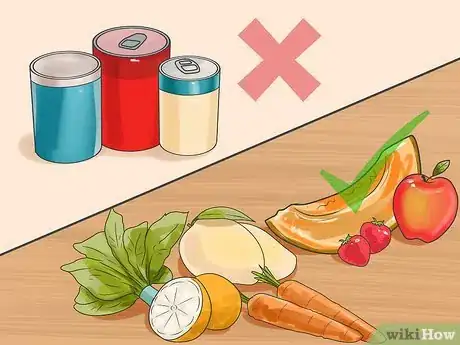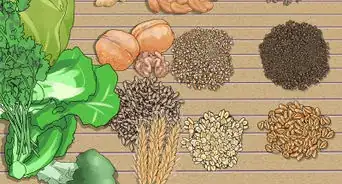This article was co-authored by wikiHow Staff. Our trained team of editors and researchers validate articles for accuracy and comprehensiveness. wikiHow's Content Management Team carefully monitors the work from our editorial staff to ensure that each article is backed by trusted research and meets our high quality standards.
wikiHow marks an article as reader-approved once it receives enough positive feedback. In this case, 86% of readers who voted found the article helpful, earning it our reader-approved status.
This article has been viewed 217,941 times.
Learn more...
Ayurvedic translates into “knowledge of life” and is a 4,000 year old system of well-being that originated in India. The philosophy of Ayurveda focuses on a person's health in a preventative, long term way and the Ayurvedic diet is a whole medical system, where you eat according to your mind-body type. Your mind-body type is known as your “dosha”, which takes into account your temperament, your metabolism, your energy level, and other aspects of your body and mind. Once you determine your mind-body type, you can structure your Ayurvedic diet around your dosha and also practice Ayurvedic eating habits that will help you stay committed to your diet.
Steps
Determining Your Mind-Body Type
-
1Be aware of the three primary mind-body types. There are three primary doshas in Ayurveda: Vata, Pitta, and Kapha. You can review the qualities of each dosha to determine your dosha or take an online Dosha quiz to determine your dosha. If you have addictive eating behaviors or an eating disorder, you may have an underlying Vata imbalance as part of your mind-body type.[1]
- Though some people may use Ayurvedic as a tactic to lose weight, it is not designed as a weight loss program. Rather, Ayurvedic focuses on ensuring you have a mind-body balance through your diet and your eating habits to have a more healthy lifestyle and way of thinking.
-
2Recognize the qualities of a Vata mind-body type. If your primary dosha is Vata, you are very focused on movement and change and possess an energetic and creative mind. Your require balance and stability in your life and low stress to feel energized and enthusiastic about life. But you are also prone to anxiety and insomnia.[2]
- Vatas tend to have irregular eating patterns, especially when feeling stressed or overworked. You may also be guided by food cravings for comfort foods like chocolate, baked goods, or pastas, rather than a consistent and healthy meal schedule, and you may be prone to skipping meals. You can have extreme eating habits that involve lots of snacking and stress eating or missing meals entirely. Your eating is often centered around stress and you may use eating as a way to deal with feelings of anxiety and imbalance.
Advertisement -
3Understand the qualities of a Pitta mind-body type. A Pitta dosha tends to be full of intensity for food, experiences, and knowledge. Pittas enjoy being challenged and using their intellect to learn new things. When you feel imbalanced or stressed, you tend to develop heat related issues in your body like heartburn, ulcers, hypertension, and inflammatory conditions. This heat can also manifest in your personality, as you may be prone to frustration, irritability, and feelings of anger.[3]
- Pittas crave order and predictability with their eating habits and diet, with structured meal times three times a day at the same time every day. You focus on stability and control in many aspects of your life, including eating, and may feel annoyed or grouchy if your meal schedule is thrown off or you eat later than usual. Pittas tend to overeat as a way to express anger, literally swallowing their anger, through eating too much at every meal. You may also view overeating as a way to rebel against stressful situations or larger issues in the world.
-
4Get familiar with the qualities of a Kapha mind-body type. This mind-body type tends to have a natural propensity for physical strength and endurance. You may be naturally athletic, with a calm personality and the ability to use critical thinking and retain information quickly. However, you may be prone to weight gain, fluid retention, and allergies if you are feeling imbalanced. You may also exhibit an aversion to change and an overall stubborn demeanor. Kaphas tend to hold on to experiences, relationships, and objects long after they stop being useful or necessary.[4]
- Kaphas usually have a natural love of eating and can become addicted to food. If you are feeling imbalanced, you may eat constantly, before and after meal times. You may use food to hide your intense emotions and as a way to avoid confrontation with others or with your own feelings and emotions.
Eating According to Your Mind-Body Type
-
1Be aware of the foods that contain the six tastes. The Ayurvedic diet focuses on creating meals around the six tastes: sweet, sour, salty, bitter, pungent, and astringent. The idea is to include all six tastes in every meal so every major food group is present on your plate and you are consuming enough nutrients. Foods that contain each of the six tastes include:[5]
- Sweet: These include foods such as whole grains, dairy, meat, chicken, fish, honey, sugar, and molasses.
- Sour: These include foods such as cheese, yogurt, alcohol, vinegar, pickled foods, tomatoes, plums, berries, and citrus fruits.
- Salty: These include foods such as seaweed, salted meats, fish, soy sauce, and any food that contains added salt.
- Bitter: These include foods such as green vegetables (leafy greens, celery, broccoli, sprouts, spinach, kale), endives, chicory, beets, and tonic water.
- Pungent: These include foods such as onions, garlic, chilies, peppers, cayenne, black pepper, cloves, ginger, mustard, and salsa.
- Astringent: These include foods such as dried beans, lentils, green apples, cauliflower, figs, pomegranates, and tea.
- The six tastes are ordered in the order you should digest them at every meal. Start with sweet foods and move down to astringent foods.
-
2Eat warm, oily, and heavy foods if you have a Vata mind-body type. Vatas should consume more sweet, salty, and sour foods and limit their consumption of pungent, bitter, and astringent foods. As a Vata, you have a light, dry, cool nature so you should counteract this with warm, oily, and heavy foods. If you are looking to lose weight, you can minimize foods high in sugar or fat and have more natural grains, and fruits and vegetables.[6]
- Consume more natural grains like barley, corn, millet, buckwheat, and rye. You should also have cooked rice, wheat, and oats every day.
- Go for sweet fruits like bananas, avocados, mangoes, plums, berries, melons, papaya, peaches, cherries and nectarines. Make it easier for your body to digest these fruits by stewing or sauteing them. Avoid dried and unripe fruits, as well as apples, cranberries, pears, and pomegranates.
- Have more cooked vegetables, using olive oil or ghee, such as asparagus, beets, green beans, sweet potatoes, turnips, broccoli, cauliflower, zucchini, and carrots. You can use spices like cardamom, cumin, ginger, salt, cloves, mustard seed, cinnamon, basil, cilantro, fennel, oregano, thyme, and black pepper, but avoid bitter herbs and spices like coriander, parsley, turmeric, and fenugeek.
- Avoid eating beans as this can aggravate your stomach as a Vata. If you must eat beans, have chickpeas, mung beans, pink lentils, and soybeans (such as tofu). If you are not vegetarian, you can have organic chicken, turkey, seafood, and eggs, and reduce your intake of red meat.
-
3Have heavy, cold, and dry foods if you have a Pitta mind-body type. Pittas should focus on sweet, bitter, and astringent tastes and avoid pungent, salty, or sour tastes. Heat can affect Pittas negatively, so you should eat heavy, cool, and dry foods and liquids. Though you can have most sweeteners, avoid molasses and honey.[7]
- You can have dairy such as butter, milk, ice cream, and ghee but you should avoid sour dairy products like yogurt, sour cream, and cheese. When cooking, you should use coconut, olive or sunflower oils, as well as soy sauce, but avoid almond, corn, and sesame oils.
- Focus on increasing your consumption of wheat, rice, barley, and oats and reducing your consumption of brown rice, corn, rye, and millet.
- You can also have sweet fruits like grapes, avocados, mangos, cherries, coconuts, pineapples, apples, oranges, and figs. Avoid sour fruits such as grapefruits, cranberries, lemons, and persimmons. Pittas should consume more cool fruits like asparagus, potatoes, leafy greens, pumpkins, broccoli, cauliflower, celery, zucchini, lettuce, okra, and green beans. Avoid hot, pungent vegetables like hot peppers, onions, garlic, tomatoes, and radishes.
- When cooking with spices, go for seasonings that are cooling and soothing like coriander, cilantro, cardamom, saffron, and fennel. Use hot spices like ginger, cumin, black pepper, clove, salt, and mustard seed sparingly. Avoid pungent seasonings like chili peppers and cayenne. You can chew on fennel seeds after meals to help your stomach acid cool down.
-
4Consume dry, light, and hot foods if you have a Kapha mind-body type. Go for foods that have a bitter, pungent, or astringent taste and avoid foods that have a sweet, sour, or salty taste.[8]
- Have very low amounts of dairy products and only have low-fat milk or low-fat yogurt. You should only have honey as a sweetener and avoid other sources of sugar, as Kaphas are prone to issues like clogged sinuses, allergies, colds, and weight gain. You should have two to three cups of ginger tea a day to help with digestion and overall health.
- You can have all types of beans as a protein in your diet, but limit your consumption of kidney beans, soybeans, and soy-based foods like tofu. Go for natural grains like corn, millet, buckwheat and rye but have less oats, rice, and wheat.
- Go for lighter fruits like pears, apples, apricots, pomegranates, and cranberries and have less heavier fruits, such as bananas, melons, dates, figs, avocados, coconuts, and oranges. Do not have any dried fruits.
- Kaphas can consume lots of vegetables in all varieties except for sweet and juicy vegetables like sweet potatoes, zucchini, and tomatoes. When cooking, use small amounts of extra virgin olive oil, almond oil, sunflower oil, mustard oil, and ghee and use a variety of pungent spices like pepper, ginger, cayenne, and mustard seed.
Practicing Ayurvedic Eating Habits
-
1Do breathing awareness meditation when you feel a craving for unhealthy foods. As part of the Ayurvedic diet, you can use breathing awareness meditation to distract yourself from an emotionally based craving for unhealthy foods or to prevent food binging. Practice meditation whenever you feel a craving coming on.[9]
- Sit in a quiet area with your hands by your sides and close your eyes. Breathe deeply, focusing on your breathing as it flows from your lungs out through your nose. Inhale and exhale with awareness.
- Let your attention follow your breath as it moves from your lungs and out your nose. Keep your eyes closed and continue to focus on your breath, pushing out all outside thoughts. Do this for five to ten minutes.
-
2Eat according to your appetite, not your emotions. Your body will send messages to your brain to indicate when it is hungry and requires food. Focusing on your body's natural need for food, rather than your emotional desire for food, will ensure you are eating enough every day. Only eat when you are hungry and stop eating when you are satisfied. However, when you are feeling really hungry, eat until you are comfortable full but not stuffed or overly full. This will allow your digestive system to process the food and not be overwhelmed by food.[10]
- Allow your stomach, rather than your emotions, to dictate how much you eat every day and when you eat. Try to do this for two weeks in a row, eating when you feel hungry, which may mean you eat at unusual times or do not eat for a period of time until you feel hunger. Then, only eat until you feel comfortably full. This will allow you to be more in touch with your body's natural eating cycle and avoid overeating or eating with your emotions.
-
3Drink a cup of warm milk or hot water and honey to reduce your sugar cravings. It can be difficult to suppress a craving for sweets while on the Ayurvedic diet. One way to stave off sugar cravings if to have a warm cup of milk or to have hot water with honey and a little bit of lemon.[11]
- If you have a constant craving for sweets, try having a cup of warm milk in the morning every day to prevent reaching for unhealthy sugar products. You can also have a cup of hot water with lemon and honey once a day to prevent sugar cravings.
-
4Consume more fresh foods and avoid pre-packaged foods. In the Ayurvedic diet, fresh foods are associated with energy, vitality, and health, while pre-packaged foods are associated with imbalance, fatigue, and staleness. Avoid canned, frozen, and pre-packaged foods to ensure you are only consuming foods that will add to your overall health. Go shopping every day or every other day at a farmer's market for fresh fruits and vegetables.[12]
- You should also minimize your consumption of leftovers and microwaved meals, as these are not considered fresh and full of energy.
-
5Have a larger lunch and a smaller dinner. The Ayurvedic diet encourages a shift to smaller meals at night to improve overall well-being and to also aid in weight loss. Your digestive system is the most alert in the middle of the day at lunch time so try to shift your portions so you have a larger lunch and a smaller dinner. This can also improve your sleep, as your body will not need to process a large meal at night, and give you more energy during the day.[13]
References
- ↑ https://www.ayurveda.com/resources/articles/ayurveda-a-brief-introduction-and-guide
- ↑ https://www.dabur.com/amp/in/en-us/about/science-of-ayurveda/ayurvedic-body-types
- ↑ https://www.dabur.com/amp/in/en-us/about/science-of-ayurveda/ayurvedic-body-types
- ↑ https://www.dabur.com/amp/in/en-us/about/science-of-ayurveda/ayurvedic-body-types
- ↑ http://www.ayurveda-holistic-medicine.com/ayurvedic-diet.html
- ↑ https://www.ayurveda.com/resources/articles/ayurveda-a-brief-introduction-and-guide
- ↑ https://www.ayurveda.com/resources/articles/ayurveda-a-brief-introduction-and-guide
- ↑ https://www.ayurveda.com/resources/articles/ayurveda-a-brief-introduction-and-guide
- ↑ https://kripalu.org/resources/breathe-stay-balanced-ayurvedic-pranayama-enhance-your-energy















-Step-3-Version-3.webp)























-Step-3-Version-3.webp)



































Medical Disclaimer
The content of this article is not intended to be a substitute for professional medical advice, examination, diagnosis, or treatment. You should always contact your doctor or other qualified healthcare professional before starting, changing, or stopping any kind of health treatment.
Read More...